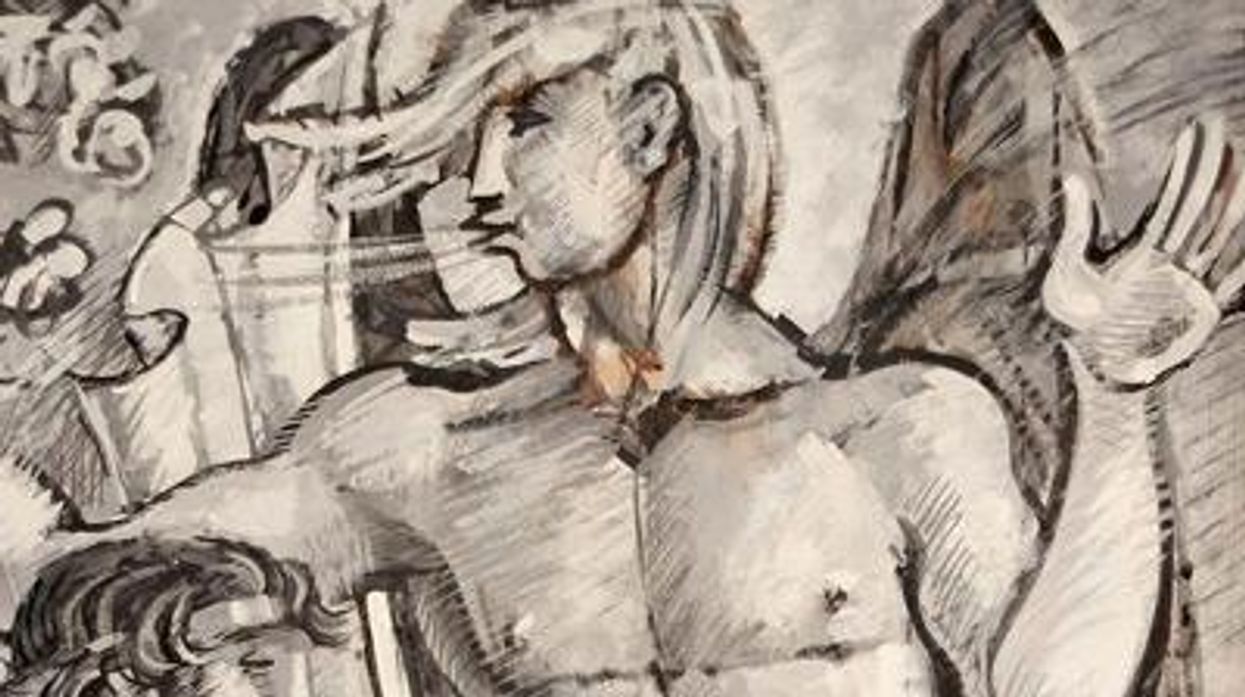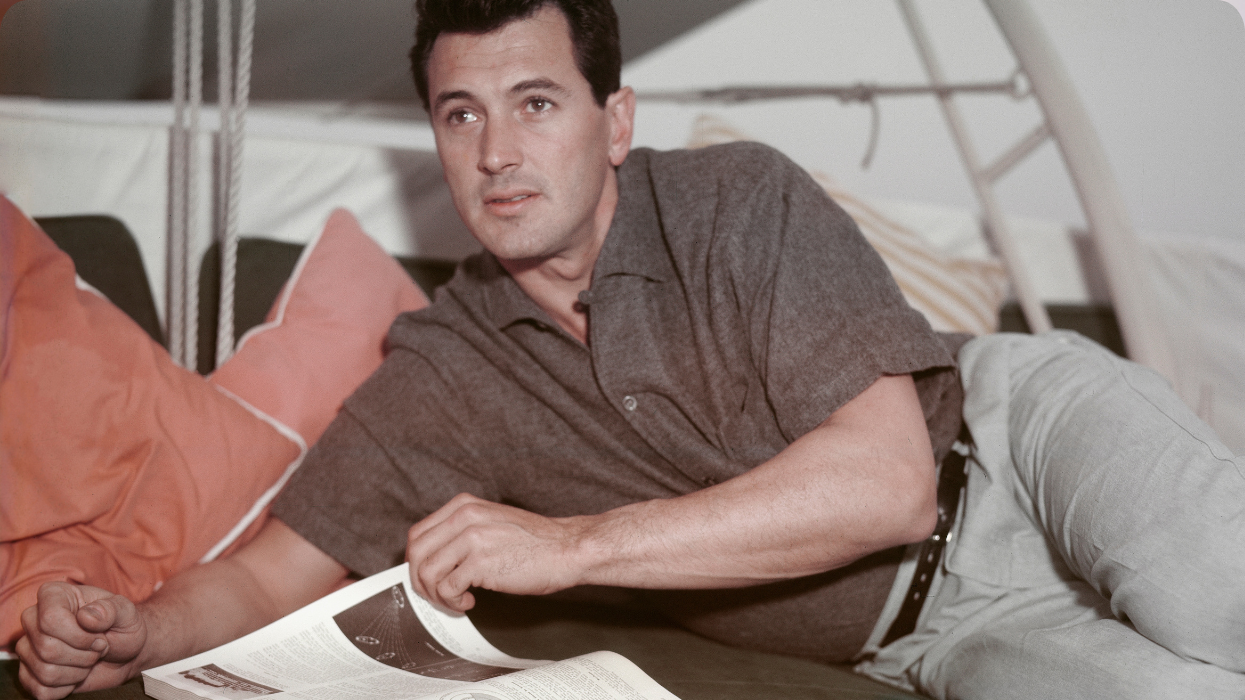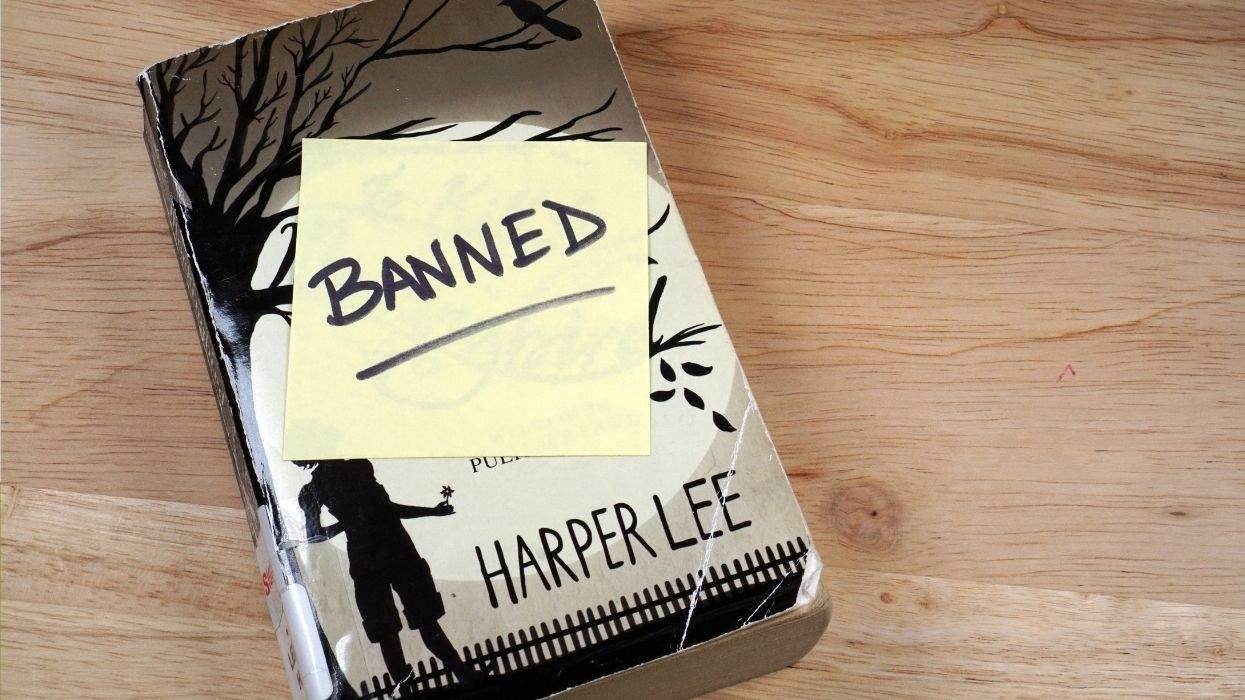A.R. Jaeger's business, Renaissance Man Antiques, is like a candy store for anyone collecting and seeking information about male figurative art from the early 20th century. So we were delighted when Jaeger contacted us to see if he could help with more material for our galleries. His stockpile in enormous, and it's matched only by his knowledge of the work. Enjoy these selections from Jaeger (and link through if you are interested in more information including purchasing details).
The Advocate: What initially drew you to early 20th-century male figurative artwork?
A.R. Jaeger: For 30 years, I've been interested in the kind of allegorical sculpture and painting that has been associated with America's grand public and commercial buildings from the 1910s, '20s, '30s and '40s. Among the best examples of this kind of public art are the murals commissioned by the U.S. Treasury Department for post offices and works created for the Works Progress Administration in the Roosevelt era. These paintings and sculptures often celebrate the American worker and offer allegories of American agriculture, manufacturing, communication and transportation. Some of the first pieces we offered for sale were mural studies and small sculptures by important WPA artists, and this kind of work still constitutes a major part of our collection.
 The first work of this sort that caught your eye?
The first work of this sort that caught your eye?
I remember it distinctly -- it was a bronze art medal by Walker Hancock, showing two nude male figures lifting up a broken column, anticipating the rebuilding of the world after World War II. (Pictured right.) Hancock also sculpted a monumental bronze for the main waiting room of 30th Street Station, the main railroad station in Philadelphia, which depicts an angel holding a half-nude, dying soldier. It is enormously poignant and beautiful.
Have there been any pieces you could just not let go of?
My friends always said that I could never let go of some of our most spectacular pieces, but by and large I feel that any piece that sells will inevitably be replaced by an equally great piece, usually something I can never predict. There are exceptions -- pieces that mean a great deal or fit in the house so perfectly -- such as a painting by Henry Soulen for the Christmas issue of a 1930s magazine, depicting people from all walks of life, including a construction worker, stockbroker, society lady, and immigrant with child. At the center of the painting are scientists suffused in a golden glow coming from a white-robed Christ figure. This painting depicts its era with such dignity and style.
Click through for a selection of artwork >>>

Nude Centurion with Horse and Shield by Richard Jackson, 1959
A tour de force of ink and watercolor techniques, this painting of a nude centurion, with his shield and horse and a Roman temple front in the background, is a rare painting by Richard Jackson, who was active in the 1950s. Jackson used his black, blue, and red colors, often blended and bleeding or spattered on the paper, in highly creative ways, and yet his techniques do not take away from the sensual nature of his subject. This painting retains its original linen mat and frame.
 Portrait of Leon Daniellen by Emlen Etting
Portrait of Leon Daniellen by Emlen EttingEmlen Etting had a lifelong interest in capturing the likenesses of handsome, glamorous friends, and he traveled in a prestigious circle of artists, writers and wealthy clients. Little is known about Leon Daniellen, but the expressive eyes, sharply etched face, and sensuous mouth captured by the artist suggest a life of beauty and sorrow. Perhaps because he sometimes collaborated with writers to illustrate books, Etting would sometimes layer text over his paintings, as he does here. Etting exhibited, over a long lifetime of painting, in more than 30 one-man and multiple-artist shows in Philadelphia, New York, Paris, and elsewhere, and his works were purchased by museums and collectors such as Walter Annenberg, Helen Hayes, and Mary Clark Rockefeller. This drawing is one of several purchased from his estate.
From Our Archives-- Artist Spotlight: Emlen Etting
Philadelphia Main Line society artist Emlen Etting was happily married, but he sure painted a lot of sailors.
 Zephyrus and Hyacinthus, Large, Important Painting by Raoul Pene duBois
Zephyrus and Hyacinthus, Large, Important Painting by Raoul Pene duBois Perhaps the largest and most important extant painting by Raoul Pene duBois, this depiction of Zephyrus and Hyacnthus is a masterpiece of grisaille effect, using varying tones of black, grey and white with only a just a touch of sepia. Greek mythology tells us that Zephyrus rivaled Apollo for the love of Hyacinthus, and when the latter two were playing quoits with discs, Zephyrus created a gust of wind that caused the disc, tragically, to strike and kill Hyacinthus instantly. Famed as a scenic and costume designer for dozens of Broadway productions beginning in the 1930s, du Bois was one of a distinguished family of artists and designers going back to his grandfather, the art critic Henri Pene du Bois. He won Tony awards for scenic design (Wonderful Town) and for costume design (
No, No Nanette); among the many other shows he designed were the
Ziegfeld Follies (1934), Jumbo (1935),
Du Barry Was a Lady (1939), and
Charley's Aunt (1953).
 Art Deco Bas-Relief Panel by Rene Chambellan
Art Deco Bas-Relief Panel by Rene ChambellanOne of the two or three most important sculptors creating bas-relief panels, grills, and other decorative elements for America's art deco buildings in the 1920s and 1930s, Rene Chambellan is known today for his work at Rockefeller Center in New York: a set of dolphin fountain heads, and a massive figure of Atlas in collaboration with Lee Lawrie. He was also a superb medalist and is well known today for creating the Newbery medal (for excellence in children's literature) and the Caldecott medal (for excellence in children's book illustration). This rare bronze panel, mounted on a walnut plaque, was sculpted in the 1930s; the medal was awarded annually through the 1970s (this example went to the Sunolin Chemical Company).
 Limited Edition Shelf With Symbolist Prints by Adolfo Magrini
Limited Edition Shelf With Symbolist Prints by Adolfo Magrini Extraordinarily rare, this rosewood and brass shelf unit incorporates a pair of symbolist/art nouveau prints featuring male nudes playing highly stylized lyres by Adolfo Magrini. The shelf unit maintains its original labels from Milan, indicating that the prints were two of a set published in the fourth volume of the
Modelli D'Arte Decorativa. The shelf was one of a limited edition produced by Bestetti and Tumminelli in Milan. Magrini is known for his sensuous paintings and graphics, including murals, posters and illustrations, influenced by art nouveau and the other great movements of the day.
 The Law, Important, Early Pair of Art Deco Drawings by Donald De Lue
The Law, Important, Early Pair of Art Deco Drawings by Donald De Lue This pair of drawings is of great importance, dating from 1932 when Donald De Lue was commissioned to undertake his first major public project -- a set of sculptures for the federal courthouse and post office in downtown Philadelphia. Widely known and appreciated over decades for his idealized nude figures shown stretching across the room -- or across the universe -- De Lue began it all here, sculpting a set of muscled, superhuman figures. Carved in granite and larger than life, these figures were meant to last forever. De Lue executed a number of sketches that capture some of his thinking and planning, and this pair has the energy and monumentality later captured in stone.
 Standing Male Nude, Important Drawing With Watercolor by Jared French
Standing Male Nude, Important Drawing With Watercolor by Jared FrenchAlong with Paul Cadmus and George Tooker, Jared French was among the first artists in America to live and work as an openly gay man, and like them, he often focused on the male nude and allegorical subjects. French used pen and ink and a ruddy watercolor wash for this nude, showing the influence of Renaissance masters in his mastery of anatomy and draftsmanship.
From Our Archives: Jared French's Magic Realism
Is all male nudity in art and photography necessarily homoerotic? Continuing to explore artists who eroticized the male figure before Tom of Finland's career began, we look at bisexual artist Jared French.
 Bathers Tray, Rare Ceramic From Laguna Beach by Pat and Covey Stewart, 1951
Bathers Tray, Rare Ceramic From Laguna Beach by Pat and Covey Stewart, 1951This very rare
Bathers piece by Pat and Covey Stewart depicts two nude male bathers along the rocky Laguna Beach coast. The Stewarts worked in Laguna Beach, Calif., from 1950 to 1952, exhibiting in the town's annual art fair and selling their ceramic wares to high-end gift shops and hotel shops across the nation.
 Nude Male w/ Upraised Arm, Drawing by John Koch
Nude Male w/ Upraised Arm, Drawing by John KochHighly esteemed for his brilliant scenes of men and women -- often wealthy and accomplished -- in music rooms, bedrooms and parlours, John Koch was influenced by Charles Hawthorne in Provincetown and the great European masters. His works have been collected by the Metropolitan Museum of Art in New York, where he lived, the National Portrait Gallery in Washington, and many other museums. This drawing has a soft, Michelangeloesque quality that beautifully demonstrates Koch's skill and sensitivity to the human figure.
From Our Archives-- Artist Spotlight: John Koch
Koch's society paintings grow more charming as time passes, but his paintings of handsome nudes reveal a more intriguing point of view.
 Sylvan Youth, Life-Size Nude Sculpture by Chester Beach, 1932
Sylvan Youth, Life-Size Nude Sculpture by Chester Beach, 1932Sculpted by one of America's most important figural artists of the 1920s, '30s and '40s, this depiction of a nude youth holding a squirrel remained in Chester Beach's studio long after his death in 1956. Cast in plaster, this piece was created in preparation for the final sculpture in marble that was commissioned by Brookgreen Gardens, one of the first eight pieces purchased by Brookgreen when it opened in 1932. Established by sculptor Anna Hyatt Huntington with the considerable wealth of her husband, Brookgreen became the largest sculpture garden of figural pieces in America, and purchased many important sculptures from struggling artists in the heart of the Depression. Beach was known as "one of the few American sculptors to adopt Rodin's vibrating surfaces throughout his work." Earlier in his career, he created a powerful male figure for the American Telephone and Telegraph building in New York and the Fountain of the Waters at the Cleveland Museum of Art.
 Two Gentlemen With Books, Rare and Fine Drawing by Gregorio Prieto
Two Gentlemen With Books, Rare and Fine Drawing by Gregorio PrietoDemonstrating the fluid economy of line so famously associated with Picasso and Matisse, this extremely fine drawing was executed by Gregorio Prieto, the Spanish artist known for his subtly homoerotic drawings and surrealist paintings. Prieto loved to depict groupings of handsome men who are presented sensually and beautifully, and was commissioned to provide illustrations and frontispieces for books such as
We Burn by Marie Carmichael Stokes. His drawings were also used to accompany
Nuevos poemas de "Las Islas Invitada" by Manuel Altolaguirre.
 Hellenic Study, Superb Art Deco Male Nude by Alexander Sambugnac
Hellenic Study, Superb Art Deco Male Nude by Alexander SambugnacSuperbly executed, this depiction of a nude warrior with upheld sword, strongly reminiscent of the stylized figures created for patriotic monuments across America and Europe in the days before World War II, was drawn by Alexander Sambugnac, a WPA artist responsible for bas reliefs in several U.S. post offices in the late 1930s. Sambugnac was born in present-day Croatia, and studied with Franz von Stuck in Germany and Antoine Bourdelle in France before immigrating to America. In addition to his WPA work, he joined a team of artists and architects who proposed a major memorial for Jose Marti, the Cuban revolutionary and hero, in Havana.
 Rare Mannerist Nude by Fred Press, circa 1940s
Rare Mannerist Nude by Fred Press, circa 1940sSculpted with finesse and sensitivity, this late Renaissance-influenced male nude figure is probably a unique piece, and is marked with Fred Press' monograph. Press was a kind of Renaissance man in mid-century design, creating new patterns for Glidden pottery after World War II and designing lines of glassware. He also issued his own sculptures in plaster or ceramic. The elongated form and complex pose of this figure makes a direct reference to mannerist sculpture, yet the open circle behind the figure and the stippled gold highlighting makes it clear that this is a product of postwar America.
 Seated Seminude Male Figure With Cross by John Lear
Seated Seminude Male Figure With Cross by John LearOver his 70-plus year career from the 1930s to the turn of the 21st century, John B. Lear focused again and again on nude or half-nude figures set in fantastic or exotic environments such as the circus, carnival, deserted beach, or Dali-esque setting. This early drawing shows his subject in a normal sitting position, with no hint of the exotic or surreal. The male figure's torso is perfectly proportioned, but is also more elongated than the stockier figures Lear favored in later years.
 Torso, Rare, Important Nude Male Sculpture by Richmond Barthe
Torso, Rare, Important Nude Male Sculpture by Richmond BartheBeautifully cast and finished by America's finest black sculptor working in the 1930s, '40s and '50s, this rare, very fine male torso demonstrates Richmond Barthe abiding focus on the male figure. Although he was a part of the Harlem Renaissance and had many important friends and clients -- including Langston Hughes, Ralph Ellison, Carl Van Vechten, Lincoln Kirstein, Paul Cadmus, and Jared French -- his open homosexuality made it difficult for him to attain the prosperity and celebrity he might have otherwise achieved. Barthe gave this piece a pale, rosy flesh tone, and added a patina to give it an old, antiqued finish.
From Our Archives: Remembering Richmond Barthe
Barthe was a key figure in the Harlem Renaissance in the 1930s, then he crashed into obscurity. Did his homosexuality have anything to do with that?
 Standing Male Nude, Pencil Drawing by William Littlefield, 1937
Standing Male Nude, Pencil Drawing by William Littlefield, 1937Powerfully expressed, with the angular stylization characteristic of art deco decorative art, this pencil drawing was executed in 1937 by William Littlefield. The artist was fascinated by the male figure and produced scenes of boxers and mythological scenes that showcased the nude. Littlefield exhibited widely in the 1930s and 1940s, and his works are in the collections of the Albright-Knox Art Gallery in Buffalo, the Museum of Modern Art in New York, and the Wadworth Atheneum in Hartford. This drawing retains its original walnut frame.
Renaissance Man Antiques
349 S. 47th St., Philadelphia, PA 19143


 The first work of this sort that caught your eye?
The first work of this sort that caught your eye? 

















































































Charlie Kirk DID say stoning gay people was the 'perfect law' — and these other heinous quotes